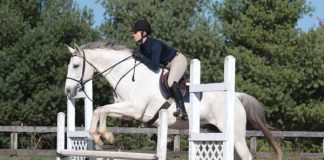 Poor saddle fit can cause pain and trauma, which often manifest as a training issue or poor performance. Joyce Harman, DVM, MRCVS, author of The Horse’s Pain-Free Back and Saddle Fit Book, The Western Horse’s Pain-Free Back and Saddle Fit Book, and two DVDs, Western Saddles and English Saddles, offers the following advice on some common signs of poor saddle fit.
Poor saddle fit can cause pain and trauma, which often manifest as a training issue or poor performance. Joyce Harman, DVM, MRCVS, author of The Horse’s Pain-Free Back and Saddle Fit Book, The Western Horse’s Pain-Free Back and Saddle Fit Book, and two DVDs, Western Saddles and English Saddles, offers the following advice on some common signs of poor saddle fit.
- Grumpiness tacking up.
The horse is visibly unhappy about being saddled. - Attitude becomes progressively worse.
The horse is more unhappy about being ridden as the ride gets longer. - Hill problems.
“A lot of horses will have difficulty either going uphill or downhill, or potentially both,” says Harman. “Sometimes, especially when the saddle is riding up on their shoulder blades, they come to a downhill and they really do not want to go down it straight. They’ll try to go sideways and evade the hill.” - Sore back or lameness.
Poor saddle fit will certainly cause horses to get sore in their back, and they may very easily get sore in their feet and legs, says Harman. In many cases, the resulting lameness will be worse while the horse is being ridden, yet when you take saddle off and jog the horse later on, it may not be as bad. - Misbehavior:
Bucking, rearing or running away. Sometimes horses run off simply because they are too much horse for the rider, but in many cases Harman says the horse’s nature as a prey animal comes out in response to pain. “If they hurt, they have a tendency to run faster, so you’ll get horses that start out fairly well-behaved, and they’ll get harder and harder to control as they get more painful.” - Spooking.
“When many horses start to hurt, they lose their focus on what their job is,” says Harman. “They look up and suddenly they’re noticing there’s a tree there, or a bush, or something they hadn’t seen because they weren’t really focused on where they were going.” - One-sided.
The horse that is hurting will often only allow the rider to post on one diagonal (if they are posting), or they will only pick up one lead at the canter.
This article originally appeared in the August 2014 issue of Horse Illustrated magazine. Click here to subscribe!





